ACC5216 Accounting Theory Assignment: Enron Case Study Analysis
VerifiedAdded on 2022/09/12
|11
|2188
|23
Report
AI Summary
This assignment analyzes the Enron scandal, a significant case of corporate fraud and bankruptcy, applying various accounting theories to understand the events leading to the company's collapse. The report begins by establishing the facts of the Enron case and discussing the reasons for the fraud and conspiracy charges against its executives. It identifies the stakeholders affected by the collapse, using stakeholder theory to highlight the impact on employees, investors, and other relevant parties. The core of the analysis involves applying accounting theories, such as positive accounting theory, to explain the decisions and actions of Enron's management. The report then compares and contrasts different accounting theories, including agency theory and stewardship theory, to determine the most appropriate theory for understanding Enron's downfall from a cost-saving perspective. The analysis concludes that positive accounting theory is the most relevant theory for Enron's cost-saving perspective, and the report uses the theory to explain the motivations behind Enron's financial practices.
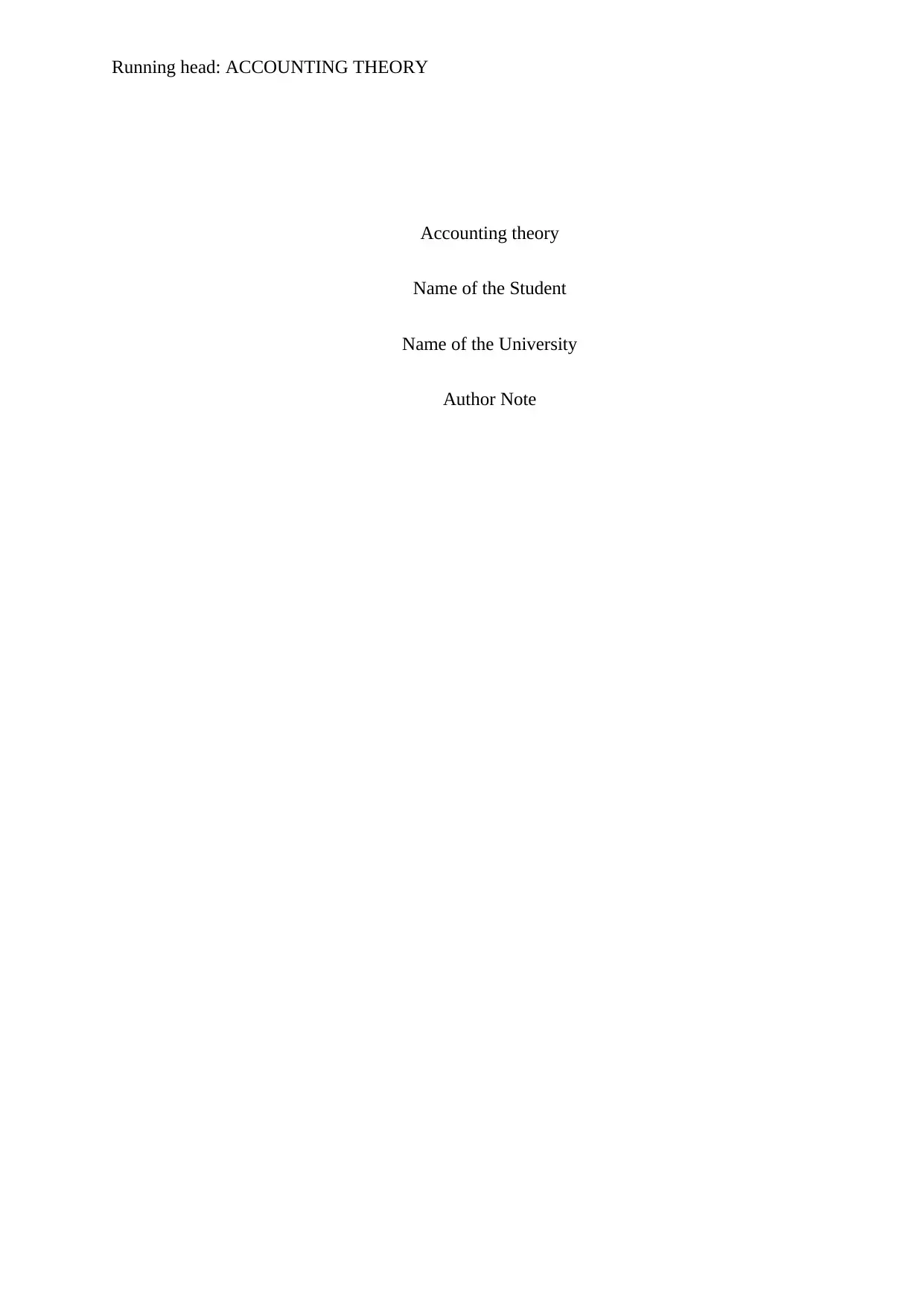
Running head: ACCOUNTING THEORY
Accounting theory
Name of the Student
Name of the University
Author Note
Accounting theory
Name of the Student
Name of the University
Author Note
Paraphrase This Document
Need a fresh take? Get an instant paraphrase of this document with our AI Paraphraser
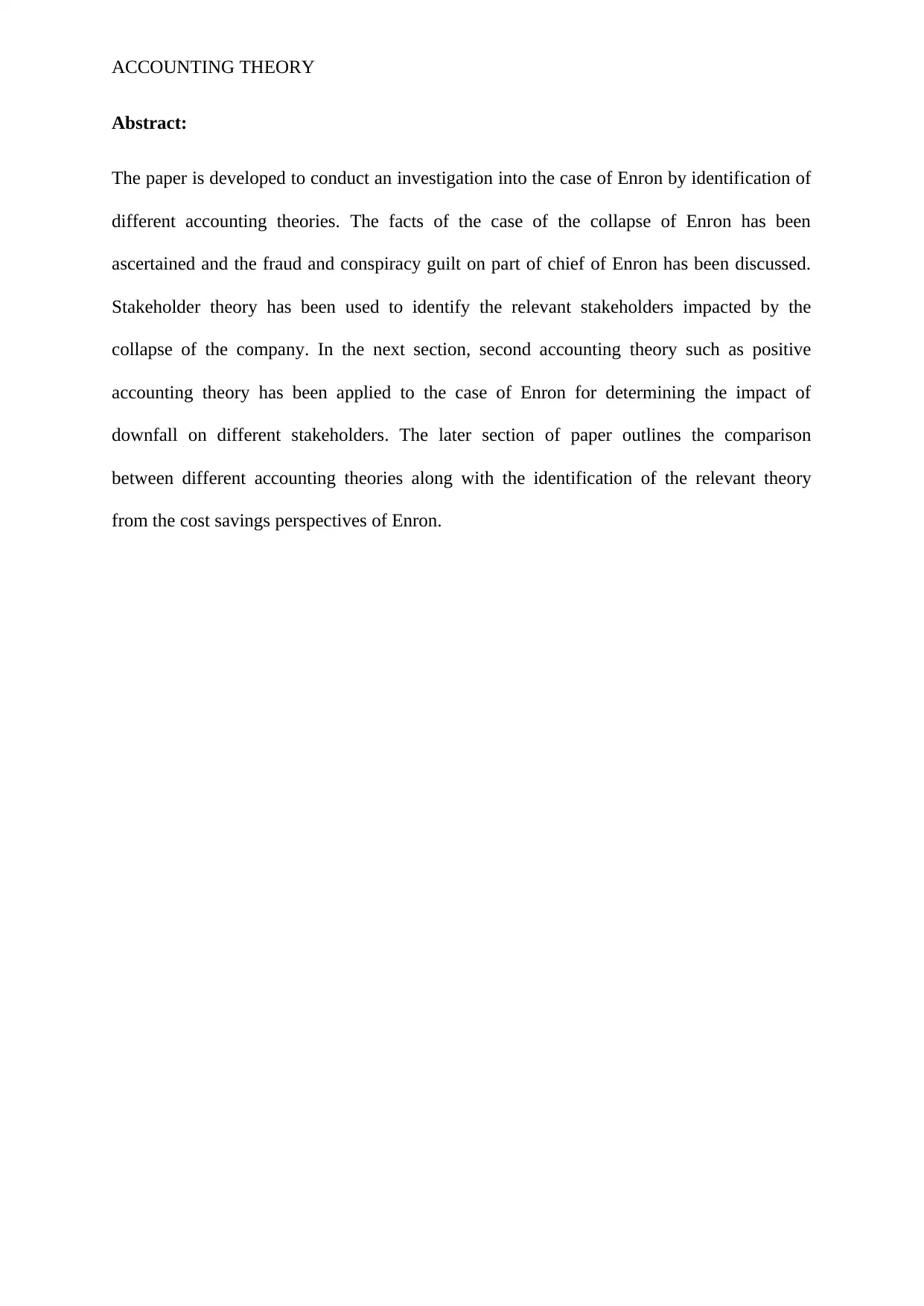
ACCOUNTING THEORY
Abstract:
The paper is developed to conduct an investigation into the case of Enron by identification of
different accounting theories. The facts of the case of the collapse of Enron has been
ascertained and the fraud and conspiracy guilt on part of chief of Enron has been discussed.
Stakeholder theory has been used to identify the relevant stakeholders impacted by the
collapse of the company. In the next section, second accounting theory such as positive
accounting theory has been applied to the case of Enron for determining the impact of
downfall on different stakeholders. The later section of paper outlines the comparison
between different accounting theories along with the identification of the relevant theory
from the cost savings perspectives of Enron.
Abstract:
The paper is developed to conduct an investigation into the case of Enron by identification of
different accounting theories. The facts of the case of the collapse of Enron has been
ascertained and the fraud and conspiracy guilt on part of chief of Enron has been discussed.
Stakeholder theory has been used to identify the relevant stakeholders impacted by the
collapse of the company. In the next section, second accounting theory such as positive
accounting theory has been applied to the case of Enron for determining the impact of
downfall on different stakeholders. The later section of paper outlines the comparison
between different accounting theories along with the identification of the relevant theory
from the cost savings perspectives of Enron.
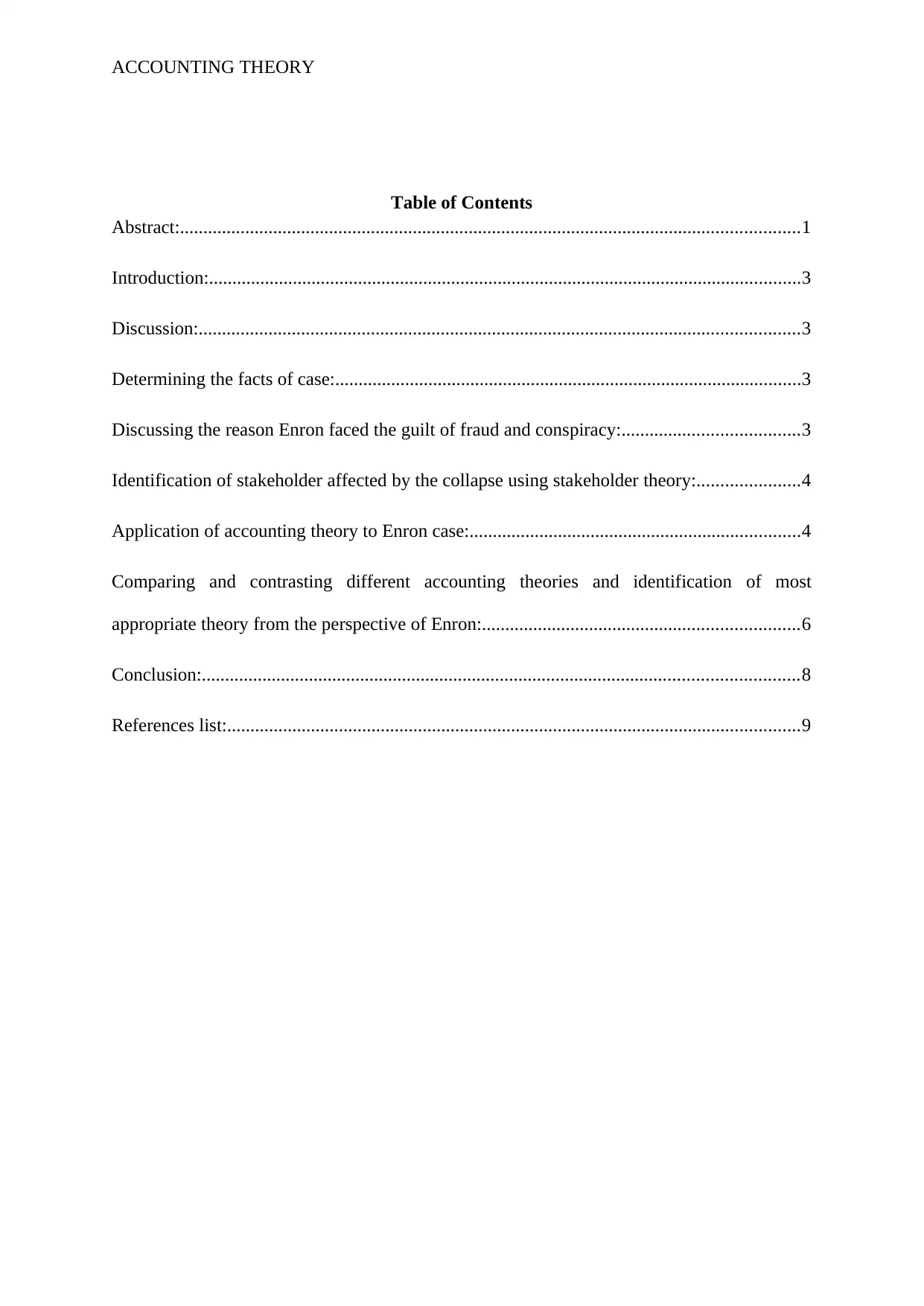
ACCOUNTING THEORY
Table of Contents
Abstract:.....................................................................................................................................1
Introduction:...............................................................................................................................3
Discussion:.................................................................................................................................3
Determining the facts of case:....................................................................................................3
Discussing the reason Enron faced the guilt of fraud and conspiracy:......................................3
Identification of stakeholder affected by the collapse using stakeholder theory:......................4
Application of accounting theory to Enron case:.......................................................................4
Comparing and contrasting different accounting theories and identification of most
appropriate theory from the perspective of Enron:....................................................................6
Conclusion:................................................................................................................................8
References list:...........................................................................................................................9
Table of Contents
Abstract:.....................................................................................................................................1
Introduction:...............................................................................................................................3
Discussion:.................................................................................................................................3
Determining the facts of case:....................................................................................................3
Discussing the reason Enron faced the guilt of fraud and conspiracy:......................................3
Identification of stakeholder affected by the collapse using stakeholder theory:......................4
Application of accounting theory to Enron case:.......................................................................4
Comparing and contrasting different accounting theories and identification of most
appropriate theory from the perspective of Enron:....................................................................6
Conclusion:................................................................................................................................8
References list:...........................................................................................................................9
⊘ This is a preview!⊘
Do you want full access?
Subscribe today to unlock all pages.

Trusted by 1+ million students worldwide
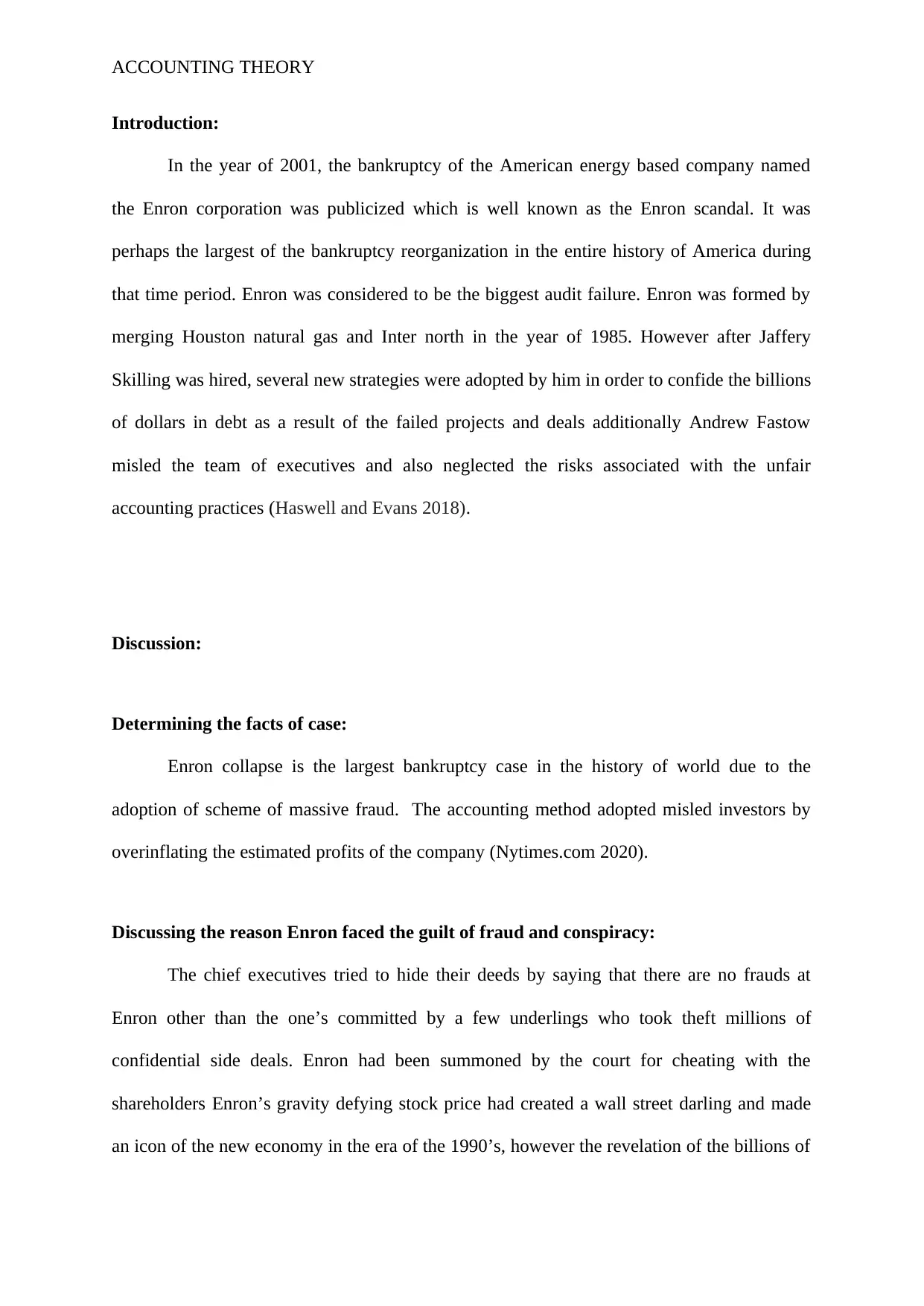
ACCOUNTING THEORY
Introduction:
In the year of 2001, the bankruptcy of the American energy based company named
the Enron corporation was publicized which is well known as the Enron scandal. It was
perhaps the largest of the bankruptcy reorganization in the entire history of America during
that time period. Enron was considered to be the biggest audit failure. Enron was formed by
merging Houston natural gas and Inter north in the year of 1985. However after Jaffery
Skilling was hired, several new strategies were adopted by him in order to confide the billions
of dollars in debt as a result of the failed projects and deals additionally Andrew Fastow
misled the team of executives and also neglected the risks associated with the unfair
accounting practices (Haswell and Evans 2018).
Discussion:
Determining the facts of case:
Enron collapse is the largest bankruptcy case in the history of world due to the
adoption of scheme of massive fraud. The accounting method adopted misled investors by
overinflating the estimated profits of the company (Nytimes.com 2020).
Discussing the reason Enron faced the guilt of fraud and conspiracy:
The chief executives tried to hide their deeds by saying that there are no frauds at
Enron other than the one’s committed by a few underlings who took theft millions of
confidential side deals. Enron had been summoned by the court for cheating with the
shareholders Enron’s gravity defying stock price had created a wall street darling and made
an icon of the new economy in the era of the 1990’s, however the revelation of the billions of
Introduction:
In the year of 2001, the bankruptcy of the American energy based company named
the Enron corporation was publicized which is well known as the Enron scandal. It was
perhaps the largest of the bankruptcy reorganization in the entire history of America during
that time period. Enron was considered to be the biggest audit failure. Enron was formed by
merging Houston natural gas and Inter north in the year of 1985. However after Jaffery
Skilling was hired, several new strategies were adopted by him in order to confide the billions
of dollars in debt as a result of the failed projects and deals additionally Andrew Fastow
misled the team of executives and also neglected the risks associated with the unfair
accounting practices (Haswell and Evans 2018).
Discussion:
Determining the facts of case:
Enron collapse is the largest bankruptcy case in the history of world due to the
adoption of scheme of massive fraud. The accounting method adopted misled investors by
overinflating the estimated profits of the company (Nytimes.com 2020).
Discussing the reason Enron faced the guilt of fraud and conspiracy:
The chief executives tried to hide their deeds by saying that there are no frauds at
Enron other than the one’s committed by a few underlings who took theft millions of
confidential side deals. Enron had been summoned by the court for cheating with the
shareholders Enron’s gravity defying stock price had created a wall street darling and made
an icon of the new economy in the era of the 1990’s, however the revelation of the billions of
Paraphrase This Document
Need a fresh take? Get an instant paraphrase of this document with our AI Paraphraser
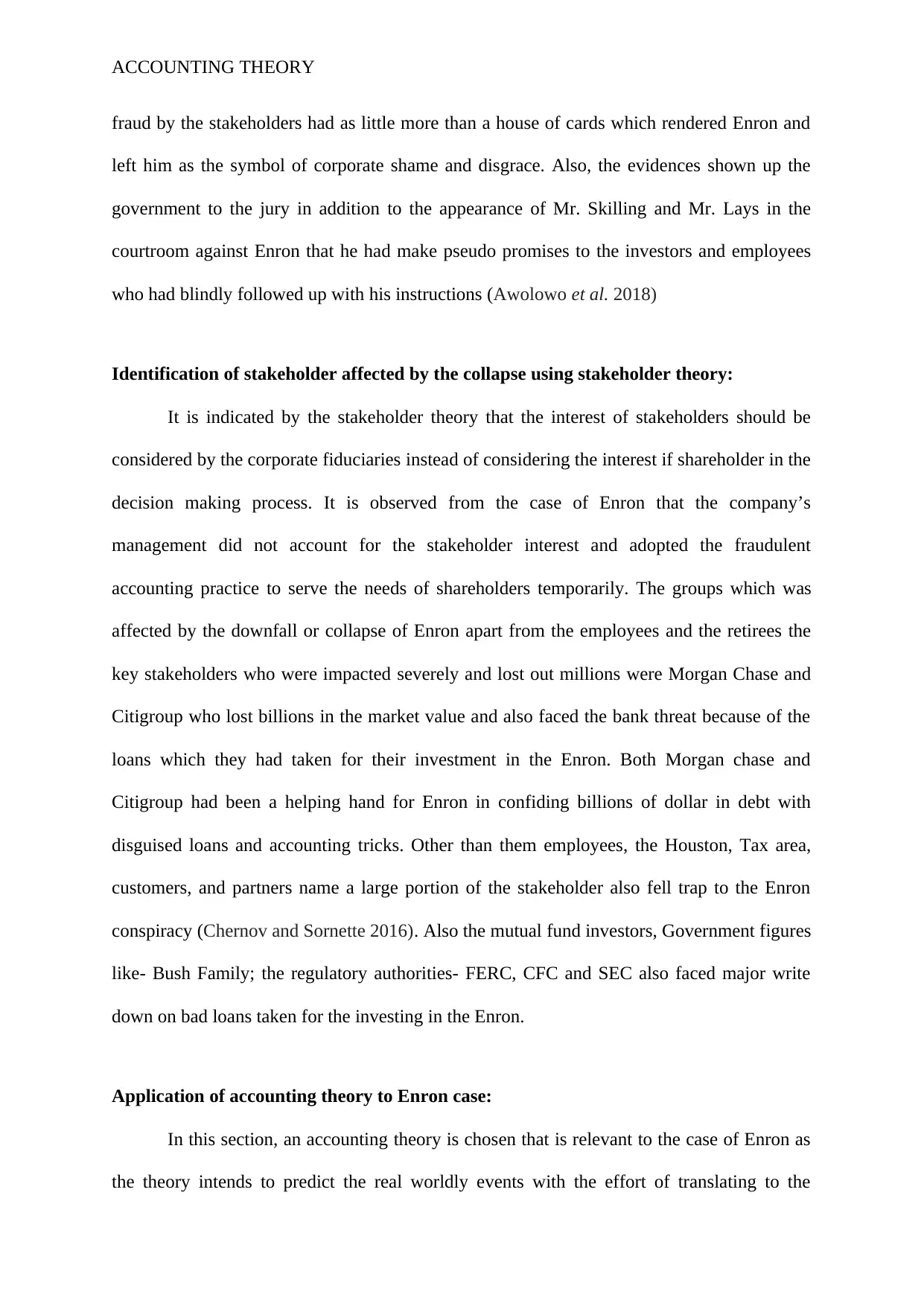
ACCOUNTING THEORY
fraud by the stakeholders had as little more than a house of cards which rendered Enron and
left him as the symbol of corporate shame and disgrace. Also, the evidences shown up the
government to the jury in addition to the appearance of Mr. Skilling and Mr. Lays in the
courtroom against Enron that he had make pseudo promises to the investors and employees
who had blindly followed up with his instructions (Awolowo et al. 2018)
Identification of stakeholder affected by the collapse using stakeholder theory:
It is indicated by the stakeholder theory that the interest of stakeholders should be
considered by the corporate fiduciaries instead of considering the interest if shareholder in the
decision making process. It is observed from the case of Enron that the company’s
management did not account for the stakeholder interest and adopted the fraudulent
accounting practice to serve the needs of shareholders temporarily. The groups which was
affected by the downfall or collapse of Enron apart from the employees and the retirees the
key stakeholders who were impacted severely and lost out millions were Morgan Chase and
Citigroup who lost billions in the market value and also faced the bank threat because of the
loans which they had taken for their investment in the Enron. Both Morgan chase and
Citigroup had been a helping hand for Enron in confiding billions of dollar in debt with
disguised loans and accounting tricks. Other than them employees, the Houston, Tax area,
customers, and partners name a large portion of the stakeholder also fell trap to the Enron
conspiracy (Chernov and Sornette 2016). Also the mutual fund investors, Government figures
like- Bush Family; the regulatory authorities- FERC, CFC and SEC also faced major write
down on bad loans taken for the investing in the Enron.
Application of accounting theory to Enron case:
In this section, an accounting theory is chosen that is relevant to the case of Enron as
the theory intends to predict the real worldly events with the effort of translating to the
fraud by the stakeholders had as little more than a house of cards which rendered Enron and
left him as the symbol of corporate shame and disgrace. Also, the evidences shown up the
government to the jury in addition to the appearance of Mr. Skilling and Mr. Lays in the
courtroom against Enron that he had make pseudo promises to the investors and employees
who had blindly followed up with his instructions (Awolowo et al. 2018)
Identification of stakeholder affected by the collapse using stakeholder theory:
It is indicated by the stakeholder theory that the interest of stakeholders should be
considered by the corporate fiduciaries instead of considering the interest if shareholder in the
decision making process. It is observed from the case of Enron that the company’s
management did not account for the stakeholder interest and adopted the fraudulent
accounting practice to serve the needs of shareholders temporarily. The groups which was
affected by the downfall or collapse of Enron apart from the employees and the retirees the
key stakeholders who were impacted severely and lost out millions were Morgan Chase and
Citigroup who lost billions in the market value and also faced the bank threat because of the
loans which they had taken for their investment in the Enron. Both Morgan chase and
Citigroup had been a helping hand for Enron in confiding billions of dollar in debt with
disguised loans and accounting tricks. Other than them employees, the Houston, Tax area,
customers, and partners name a large portion of the stakeholder also fell trap to the Enron
conspiracy (Chernov and Sornette 2016). Also the mutual fund investors, Government figures
like- Bush Family; the regulatory authorities- FERC, CFC and SEC also faced major write
down on bad loans taken for the investing in the Enron.
Application of accounting theory to Enron case:
In this section, an accounting theory is chosen that is relevant to the case of Enron as
the theory intends to predict the real worldly events with the effort of translating to the
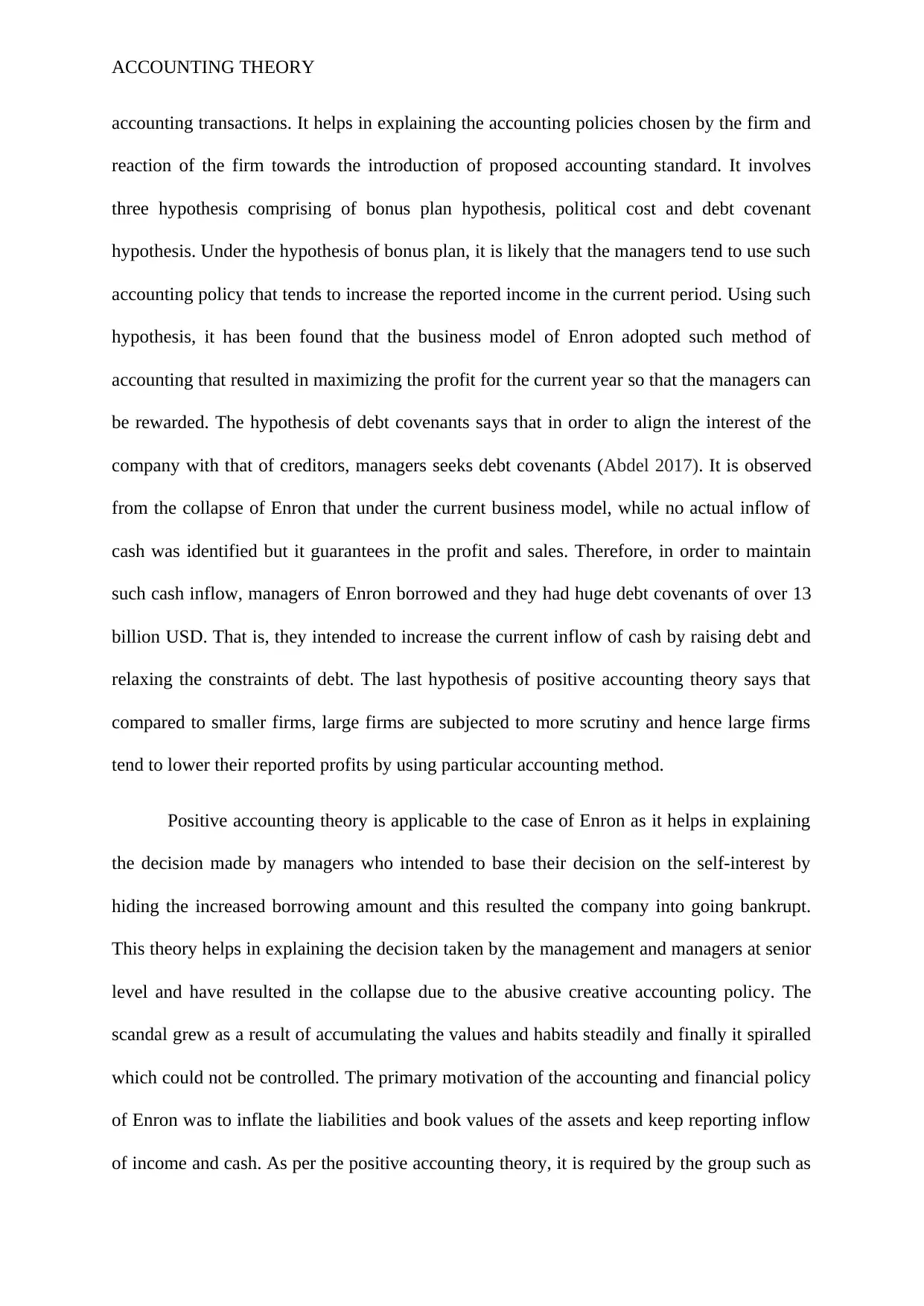
ACCOUNTING THEORY
accounting transactions. It helps in explaining the accounting policies chosen by the firm and
reaction of the firm towards the introduction of proposed accounting standard. It involves
three hypothesis comprising of bonus plan hypothesis, political cost and debt covenant
hypothesis. Under the hypothesis of bonus plan, it is likely that the managers tend to use such
accounting policy that tends to increase the reported income in the current period. Using such
hypothesis, it has been found that the business model of Enron adopted such method of
accounting that resulted in maximizing the profit for the current year so that the managers can
be rewarded. The hypothesis of debt covenants says that in order to align the interest of the
company with that of creditors, managers seeks debt covenants (Abdel 2017). It is observed
from the collapse of Enron that under the current business model, while no actual inflow of
cash was identified but it guarantees in the profit and sales. Therefore, in order to maintain
such cash inflow, managers of Enron borrowed and they had huge debt covenants of over 13
billion USD. That is, they intended to increase the current inflow of cash by raising debt and
relaxing the constraints of debt. The last hypothesis of positive accounting theory says that
compared to smaller firms, large firms are subjected to more scrutiny and hence large firms
tend to lower their reported profits by using particular accounting method.
Positive accounting theory is applicable to the case of Enron as it helps in explaining
the decision made by managers who intended to base their decision on the self-interest by
hiding the increased borrowing amount and this resulted the company into going bankrupt.
This theory helps in explaining the decision taken by the management and managers at senior
level and have resulted in the collapse due to the abusive creative accounting policy. The
scandal grew as a result of accumulating the values and habits steadily and finally it spiralled
which could not be controlled. The primary motivation of the accounting and financial policy
of Enron was to inflate the liabilities and book values of the assets and keep reporting inflow
of income and cash. As per the positive accounting theory, it is required by the group such as
accounting transactions. It helps in explaining the accounting policies chosen by the firm and
reaction of the firm towards the introduction of proposed accounting standard. It involves
three hypothesis comprising of bonus plan hypothesis, political cost and debt covenant
hypothesis. Under the hypothesis of bonus plan, it is likely that the managers tend to use such
accounting policy that tends to increase the reported income in the current period. Using such
hypothesis, it has been found that the business model of Enron adopted such method of
accounting that resulted in maximizing the profit for the current year so that the managers can
be rewarded. The hypothesis of debt covenants says that in order to align the interest of the
company with that of creditors, managers seeks debt covenants (Abdel 2017). It is observed
from the collapse of Enron that under the current business model, while no actual inflow of
cash was identified but it guarantees in the profit and sales. Therefore, in order to maintain
such cash inflow, managers of Enron borrowed and they had huge debt covenants of over 13
billion USD. That is, they intended to increase the current inflow of cash by raising debt and
relaxing the constraints of debt. The last hypothesis of positive accounting theory says that
compared to smaller firms, large firms are subjected to more scrutiny and hence large firms
tend to lower their reported profits by using particular accounting method.
Positive accounting theory is applicable to the case of Enron as it helps in explaining
the decision made by managers who intended to base their decision on the self-interest by
hiding the increased borrowing amount and this resulted the company into going bankrupt.
This theory helps in explaining the decision taken by the management and managers at senior
level and have resulted in the collapse due to the abusive creative accounting policy. The
scandal grew as a result of accumulating the values and habits steadily and finally it spiralled
which could not be controlled. The primary motivation of the accounting and financial policy
of Enron was to inflate the liabilities and book values of the assets and keep reporting inflow
of income and cash. As per the positive accounting theory, it is required by the group such as
⊘ This is a preview!⊘
Do you want full access?
Subscribe today to unlock all pages.

Trusted by 1+ million students worldwide
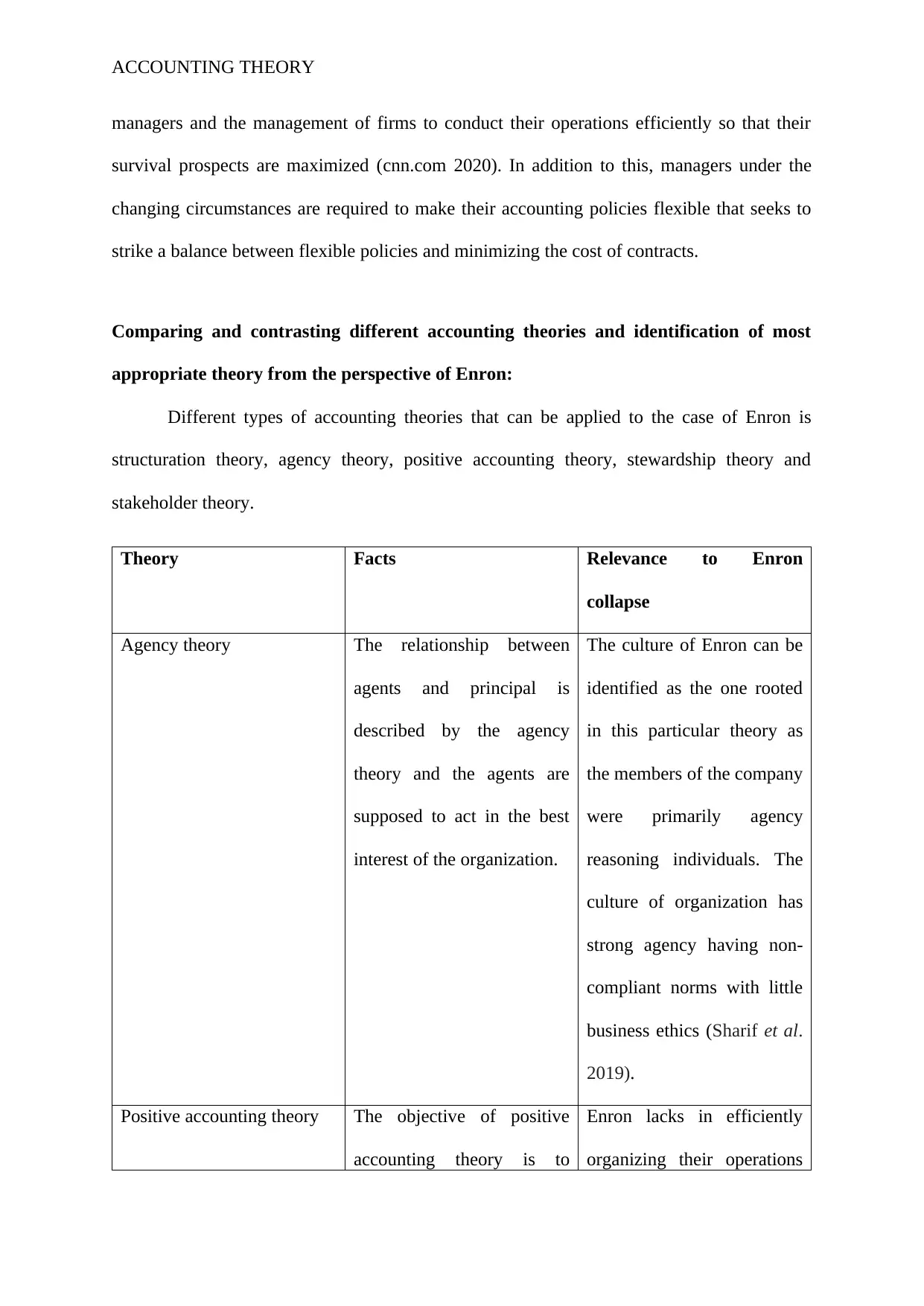
ACCOUNTING THEORY
managers and the management of firms to conduct their operations efficiently so that their
survival prospects are maximized (cnn.com 2020). In addition to this, managers under the
changing circumstances are required to make their accounting policies flexible that seeks to
strike a balance between flexible policies and minimizing the cost of contracts.
Comparing and contrasting different accounting theories and identification of most
appropriate theory from the perspective of Enron:
Different types of accounting theories that can be applied to the case of Enron is
structuration theory, agency theory, positive accounting theory, stewardship theory and
stakeholder theory.
Theory Facts Relevance to Enron
collapse
Agency theory The relationship between
agents and principal is
described by the agency
theory and the agents are
supposed to act in the best
interest of the organization.
The culture of Enron can be
identified as the one rooted
in this particular theory as
the members of the company
were primarily agency
reasoning individuals. The
culture of organization has
strong agency having non-
compliant norms with little
business ethics (Sharif et al.
2019).
Positive accounting theory The objective of positive
accounting theory is to
Enron lacks in efficiently
organizing their operations
managers and the management of firms to conduct their operations efficiently so that their
survival prospects are maximized (cnn.com 2020). In addition to this, managers under the
changing circumstances are required to make their accounting policies flexible that seeks to
strike a balance between flexible policies and minimizing the cost of contracts.
Comparing and contrasting different accounting theories and identification of most
appropriate theory from the perspective of Enron:
Different types of accounting theories that can be applied to the case of Enron is
structuration theory, agency theory, positive accounting theory, stewardship theory and
stakeholder theory.
Theory Facts Relevance to Enron
collapse
Agency theory The relationship between
agents and principal is
described by the agency
theory and the agents are
supposed to act in the best
interest of the organization.
The culture of Enron can be
identified as the one rooted
in this particular theory as
the members of the company
were primarily agency
reasoning individuals. The
culture of organization has
strong agency having non-
compliant norms with little
business ethics (Sharif et al.
2019).
Positive accounting theory The objective of positive
accounting theory is to
Enron lacks in efficiently
organizing their operations
Paraphrase This Document
Need a fresh take? Get an instant paraphrase of this document with our AI Paraphraser
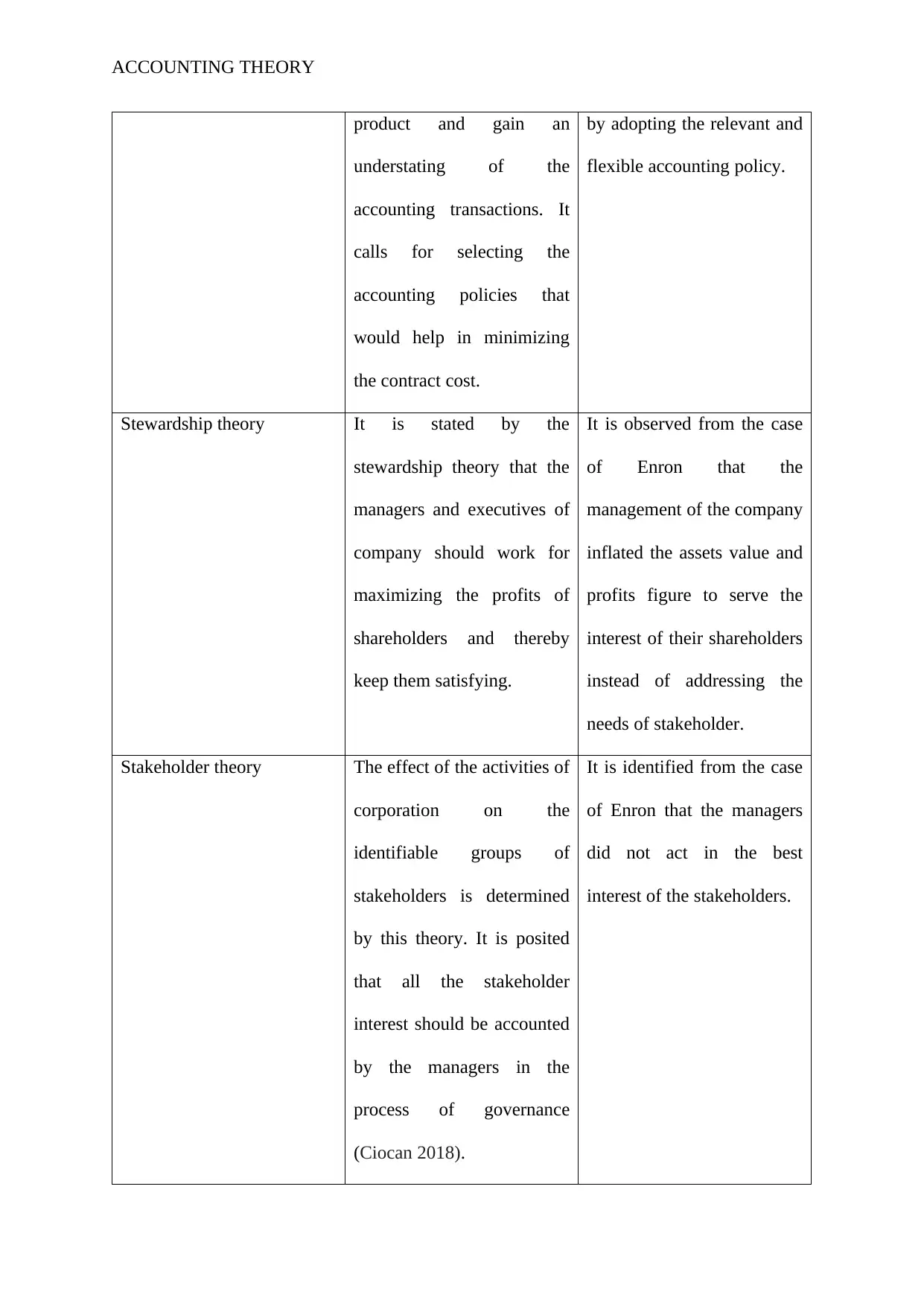
ACCOUNTING THEORY
product and gain an
understating of the
accounting transactions. It
calls for selecting the
accounting policies that
would help in minimizing
the contract cost.
by adopting the relevant and
flexible accounting policy.
Stewardship theory It is stated by the
stewardship theory that the
managers and executives of
company should work for
maximizing the profits of
shareholders and thereby
keep them satisfying.
It is observed from the case
of Enron that the
management of the company
inflated the assets value and
profits figure to serve the
interest of their shareholders
instead of addressing the
needs of stakeholder.
Stakeholder theory The effect of the activities of
corporation on the
identifiable groups of
stakeholders is determined
by this theory. It is posited
that all the stakeholder
interest should be accounted
by the managers in the
process of governance
(Ciocan 2018).
It is identified from the case
of Enron that the managers
did not act in the best
interest of the stakeholders.
product and gain an
understating of the
accounting transactions. It
calls for selecting the
accounting policies that
would help in minimizing
the contract cost.
by adopting the relevant and
flexible accounting policy.
Stewardship theory It is stated by the
stewardship theory that the
managers and executives of
company should work for
maximizing the profits of
shareholders and thereby
keep them satisfying.
It is observed from the case
of Enron that the
management of the company
inflated the assets value and
profits figure to serve the
interest of their shareholders
instead of addressing the
needs of stakeholder.
Stakeholder theory The effect of the activities of
corporation on the
identifiable groups of
stakeholders is determined
by this theory. It is posited
that all the stakeholder
interest should be accounted
by the managers in the
process of governance
(Ciocan 2018).
It is identified from the case
of Enron that the managers
did not act in the best
interest of the stakeholders.
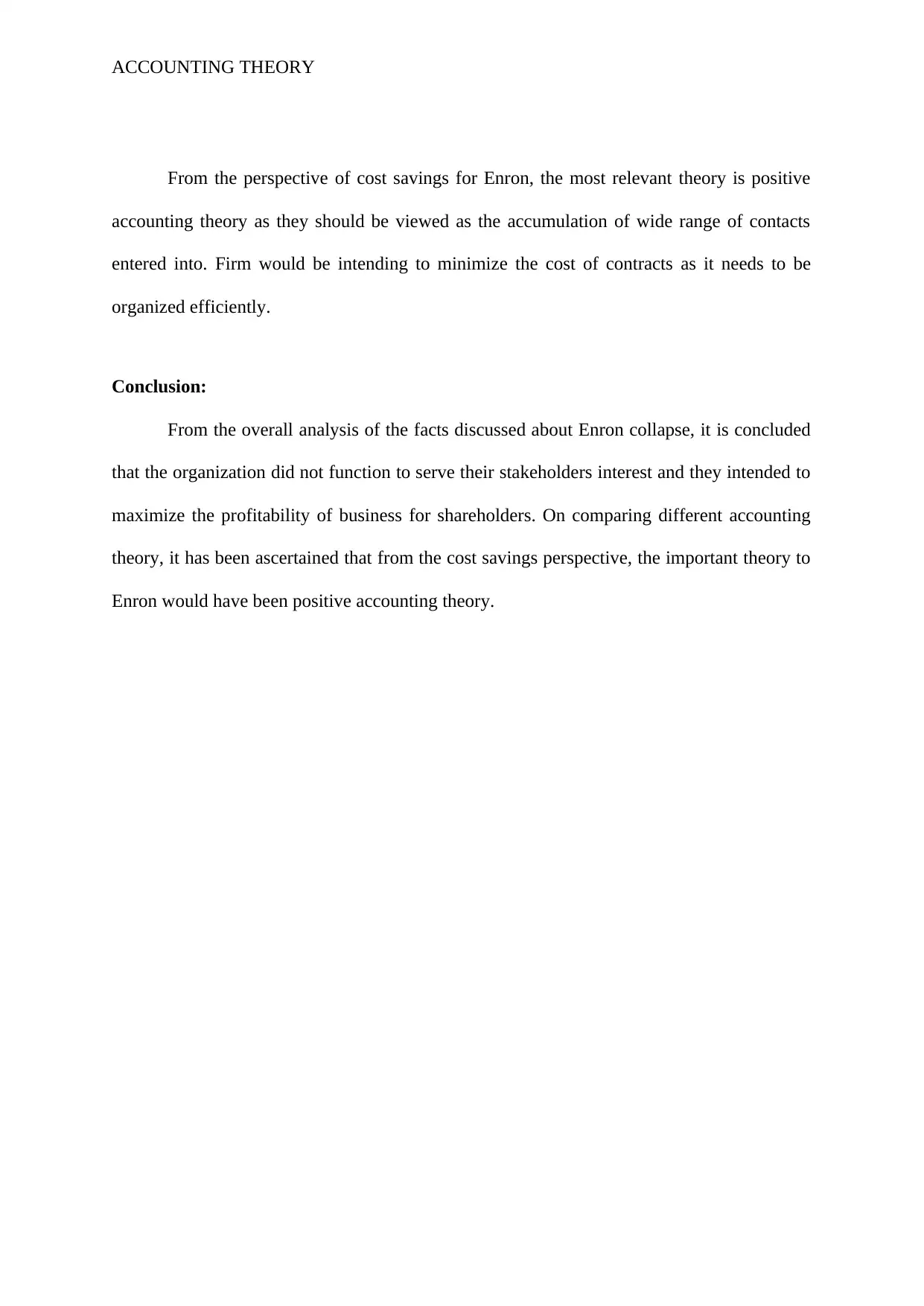
ACCOUNTING THEORY
From the perspective of cost savings for Enron, the most relevant theory is positive
accounting theory as they should be viewed as the accumulation of wide range of contacts
entered into. Firm would be intending to minimize the cost of contracts as it needs to be
organized efficiently.
Conclusion:
From the overall analysis of the facts discussed about Enron collapse, it is concluded
that the organization did not function to serve their stakeholders interest and they intended to
maximize the profitability of business for shareholders. On comparing different accounting
theory, it has been ascertained that from the cost savings perspective, the important theory to
Enron would have been positive accounting theory.
From the perspective of cost savings for Enron, the most relevant theory is positive
accounting theory as they should be viewed as the accumulation of wide range of contacts
entered into. Firm would be intending to minimize the cost of contracts as it needs to be
organized efficiently.
Conclusion:
From the overall analysis of the facts discussed about Enron collapse, it is concluded
that the organization did not function to serve their stakeholders interest and they intended to
maximize the profitability of business for shareholders. On comparing different accounting
theory, it has been ascertained that from the cost savings perspective, the important theory to
Enron would have been positive accounting theory.
⊘ This is a preview!⊘
Do you want full access?
Subscribe today to unlock all pages.

Trusted by 1+ million students worldwide
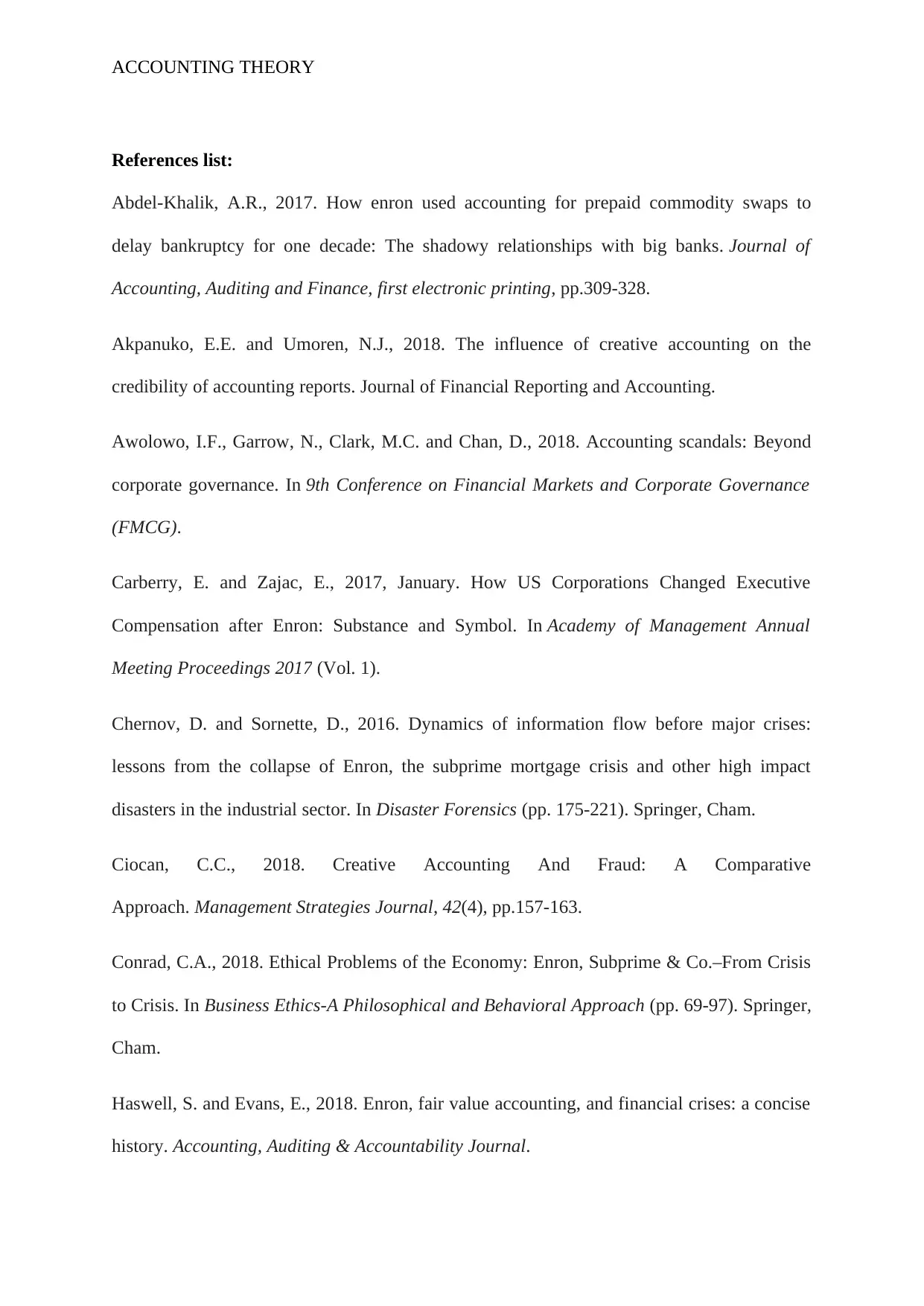
ACCOUNTING THEORY
References list:
Abdel-Khalik, A.R., 2017. How enron used accounting for prepaid commodity swaps to
delay bankruptcy for one decade: The shadowy relationships with big banks. Journal of
Accounting, Auditing and Finance, first electronic printing, pp.309-328.
Akpanuko, E.E. and Umoren, N.J., 2018. The influence of creative accounting on the
credibility of accounting reports. Journal of Financial Reporting and Accounting.
Awolowo, I.F., Garrow, N., Clark, M.C. and Chan, D., 2018. Accounting scandals: Beyond
corporate governance. In 9th Conference on Financial Markets and Corporate Governance
(FMCG).
Carberry, E. and Zajac, E., 2017, January. How US Corporations Changed Executive
Compensation after Enron: Substance and Symbol. In Academy of Management Annual
Meeting Proceedings 2017 (Vol. 1).
Chernov, D. and Sornette, D., 2016. Dynamics of information flow before major crises:
lessons from the collapse of Enron, the subprime mortgage crisis and other high impact
disasters in the industrial sector. In Disaster Forensics (pp. 175-221). Springer, Cham.
Ciocan, C.C., 2018. Creative Accounting And Fraud: A Comparative
Approach. Management Strategies Journal, 42(4), pp.157-163.
Conrad, C.A., 2018. Ethical Problems of the Economy: Enron, Subprime & Co.–From Crisis
to Crisis. In Business Ethics-A Philosophical and Behavioral Approach (pp. 69-97). Springer,
Cham.
Haswell, S. and Evans, E., 2018. Enron, fair value accounting, and financial crises: a concise
history. Accounting, Auditing & Accountability Journal.
References list:
Abdel-Khalik, A.R., 2017. How enron used accounting for prepaid commodity swaps to
delay bankruptcy for one decade: The shadowy relationships with big banks. Journal of
Accounting, Auditing and Finance, first electronic printing, pp.309-328.
Akpanuko, E.E. and Umoren, N.J., 2018. The influence of creative accounting on the
credibility of accounting reports. Journal of Financial Reporting and Accounting.
Awolowo, I.F., Garrow, N., Clark, M.C. and Chan, D., 2018. Accounting scandals: Beyond
corporate governance. In 9th Conference on Financial Markets and Corporate Governance
(FMCG).
Carberry, E. and Zajac, E., 2017, January. How US Corporations Changed Executive
Compensation after Enron: Substance and Symbol. In Academy of Management Annual
Meeting Proceedings 2017 (Vol. 1).
Chernov, D. and Sornette, D., 2016. Dynamics of information flow before major crises:
lessons from the collapse of Enron, the subprime mortgage crisis and other high impact
disasters in the industrial sector. In Disaster Forensics (pp. 175-221). Springer, Cham.
Ciocan, C.C., 2018. Creative Accounting And Fraud: A Comparative
Approach. Management Strategies Journal, 42(4), pp.157-163.
Conrad, C.A., 2018. Ethical Problems of the Economy: Enron, Subprime & Co.–From Crisis
to Crisis. In Business Ethics-A Philosophical and Behavioral Approach (pp. 69-97). Springer,
Cham.
Haswell, S. and Evans, E., 2018. Enron, fair value accounting, and financial crises: a concise
history. Accounting, Auditing & Accountability Journal.
Paraphrase This Document
Need a fresh take? Get an instant paraphrase of this document with our AI Paraphraser
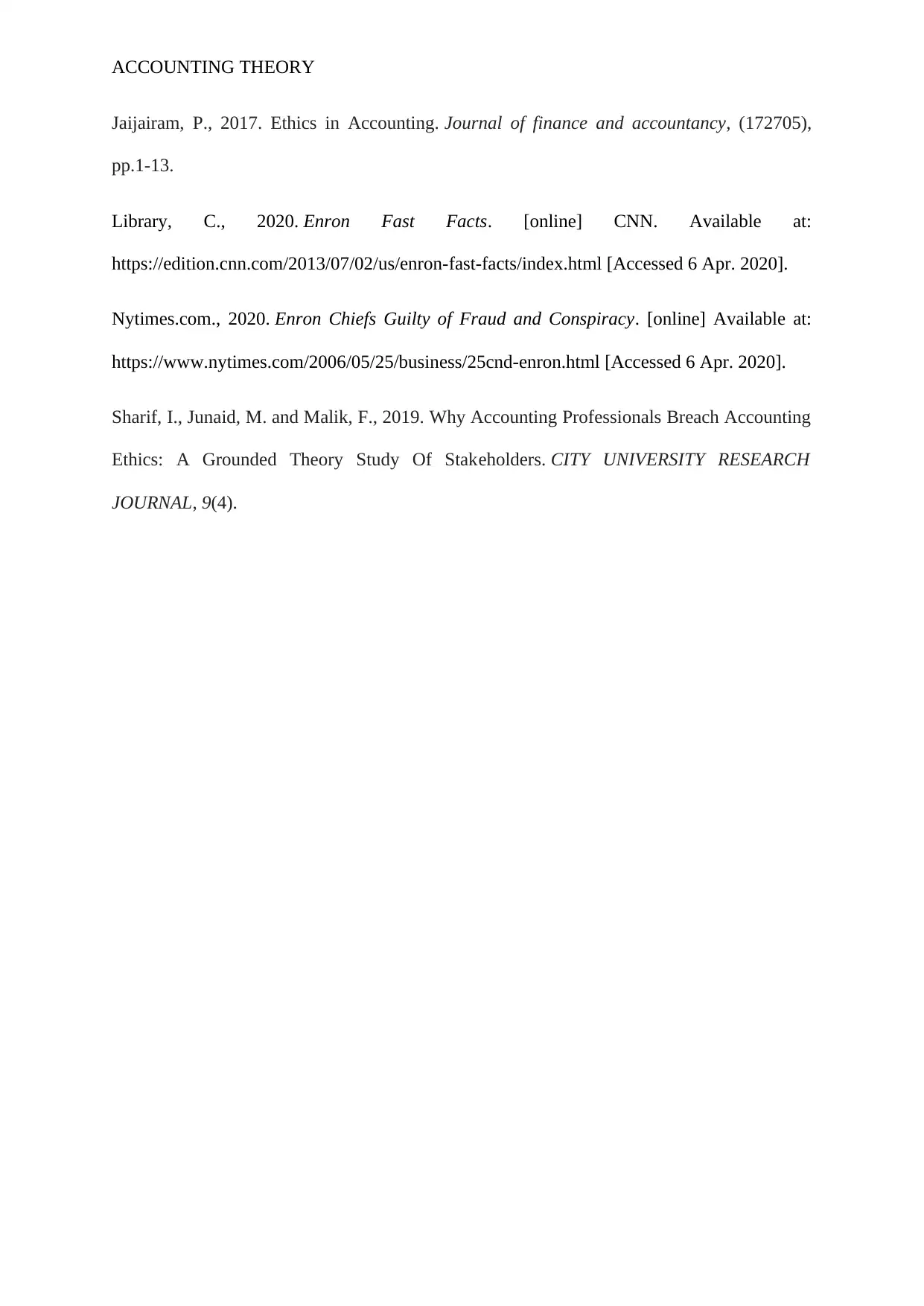
ACCOUNTING THEORY
Jaijairam, P., 2017. Ethics in Accounting. Journal of finance and accountancy, (172705),
pp.1-13.
Library, C., 2020. Enron Fast Facts. [online] CNN. Available at:
https://edition.cnn.com/2013/07/02/us/enron-fast-facts/index.html [Accessed 6 Apr. 2020].
Nytimes.com., 2020. Enron Chiefs Guilty of Fraud and Conspiracy. [online] Available at:
https://www.nytimes.com/2006/05/25/business/25cnd-enron.html [Accessed 6 Apr. 2020].
Sharif, I., Junaid, M. and Malik, F., 2019. Why Accounting Professionals Breach Accounting
Ethics: A Grounded Theory Study Of Stakeholders. CITY UNIVERSITY RESEARCH
JOURNAL, 9(4).
Jaijairam, P., 2017. Ethics in Accounting. Journal of finance and accountancy, (172705),
pp.1-13.
Library, C., 2020. Enron Fast Facts. [online] CNN. Available at:
https://edition.cnn.com/2013/07/02/us/enron-fast-facts/index.html [Accessed 6 Apr. 2020].
Nytimes.com., 2020. Enron Chiefs Guilty of Fraud and Conspiracy. [online] Available at:
https://www.nytimes.com/2006/05/25/business/25cnd-enron.html [Accessed 6 Apr. 2020].
Sharif, I., Junaid, M. and Malik, F., 2019. Why Accounting Professionals Breach Accounting
Ethics: A Grounded Theory Study Of Stakeholders. CITY UNIVERSITY RESEARCH
JOURNAL, 9(4).
1 out of 11
Related Documents
Your All-in-One AI-Powered Toolkit for Academic Success.
+13062052269
info@desklib.com
Available 24*7 on WhatsApp / Email
![[object Object]](/_next/static/media/star-bottom.7253800d.svg)
Unlock your academic potential
Copyright © 2020–2025 A2Z Services. All Rights Reserved. Developed and managed by ZUCOL.





